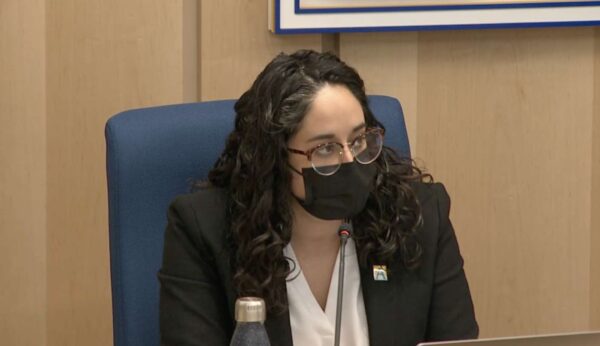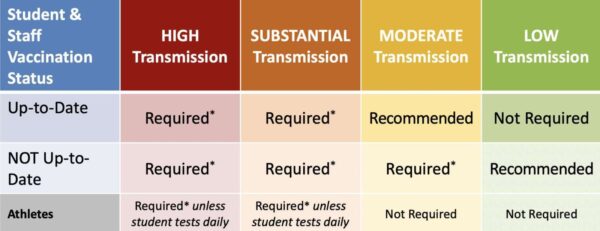
Arlington Public Schools says it will require masks when community transmission levels of Covid are high and substantial — with the caveat that parents can opt out in light of a new state law.
Meanwhile, it will not be reinstating its fledgling Virtual Learning Program (VLP) next school year.
APS reaffirmed its mask requirement during a School Board meeting last night (Thursday) while acknowledging parents have the right to opt out starting March 1, per a new law passed on Monday. Senate Bill 739 codified Gov. Glenn Youngkin’s second executive order after entering office, which allowed parents to opt their children out of mask requirements. The school system had attempted to buck the executive order and joined six other Northern Virginia school boards in a lawsuit challenging Youngkin’s order, but the new law makes those efforts moot.
Now, APS will require vaccinated staff and students to wear masks when community transmission is high and substantial. Unvaccinated staff and students will also have to wear masks when transmission is moderate.
“Our plan will and always has been to use science and data to decide when to ease masking,” Superintendent Francisco Durán said. “We all want to get to a place where we can see each other’s faces remove our masks safely, but we don’t want to do that when it’s too soon, and undo the progress that we’ve made.”

The change in masking policy comes as the Arlington School Board voted unanimously (4-0) to “pause” an in-house virtual learning program designed to meet the needs of families who did not feel comfortable with in-person learning during the pandemic. (School Board member Reid Goldstein was not present to vote.)
“We started this process with a sense of optimism… and yet our vision didn’t match our capabilities,” School Board member Cristina Diaz-Torres said. “Our intent did not match our impact. We did this fast, we — in hindsight — can look around and see many missteps and errors in communication.”
School Board member and VLP liaison Mary Kadera said she was tempted to vote against the pause because its rationale has “not been clearly and convincingly communicated.”
“However, because I have invested a great deal of time, energy and political capital in getting this recommendation to a stable state, and because I believe Virtual Virginia can and will provide robust instruction, I will vote to support it,” she said.
The VLP provided a combination of live, virtual instruction by APS teachers and independent work through third-party online education vendors, including Virtual Virginia. It served about 570 students in total: mostly students of color, students with disabilities, low-income students and students learning English. APS set aside about $10.5 million in American Rescue Plan Act funding to cover the program costs.
But, six months into the school year, APS concluded the program in its current form should end because it is too expensive and academic performance in the VLP is worse when compared to student performance in brick-and-mortar schools, among other concerns.
The breakdown of students earning Ds and Es in the first quarter is as follows:
- Middle schoolers: 17% in the VLP, 4% in-person
- High schoolers: 17% in the VLP, 10% at high school
- English-language learning middle school students: 31% in the VLP, 11% in-person
- Students with disabilities in middle school: 24% in the VLP, 8% in-person
For the second quarter:
- Middle schoolers: 26% in the VLP, 5% in-person
- High schoolers: 23% in the VLP, 12% in-person
- English-language learning middle school students: 39% in the VLP, 15% in-person
- Students with disabilities in middle school: 33% in the VLP, 10% in-person
Teachers criticized how APS used academic data to justify the pause.
“You cannot compare our student population to the entire spectrum of APS, when we are essentially a Title I school,” said teacher Jed Bobadier. “That’s a bad data analysis. We compare students to themselves over time. That type of cherry-picked data serves an agenda.”
The vote came despite pleas from parents.
“No one wants to improve the VLP more than VLP parents, but this pause is not the right way to do it,” said parent Tia McCoy. “The end goal doesn’t justify the means proposed.”
And some with immunocompromised children are worried students and families will be at greater risk of COVID-19 infection with the mask-optional change coming next month.
“This is all particularly tough at a time when we know learning loss and personal hardship is great, when we know other safety measures are threatened,” said parent Jenny Apter. “Mask mandates are on the table as we’ve already heard tonight, and I would urge you to keep them in place and urge families not to opt out.”
Families can apply through March 7 for a medical exemption to continue with virtual instruction if they or a family member has a medical condition that complicates going to school every day.
APS will convene a task force to draft a framework for a future, permanent virtual learning option. The findings of this task force will be presented this December.

